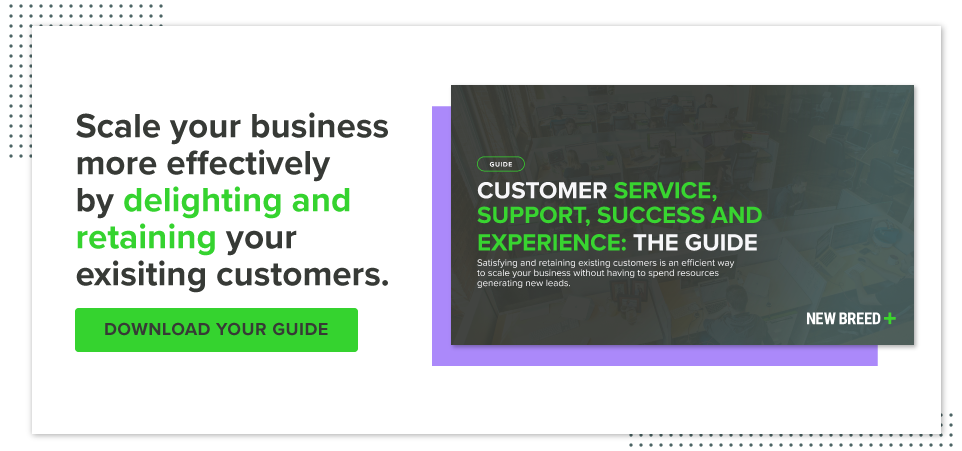.png?width=860&name=C%20Suite%20(1).png)
When it comes to generating revenue for your business, most companies invest a lot of time in bringing in new customers. While bringing in new business is great for scaling your company, it isn’t the only place you should be focused on generating revenue.
If they only focus on bringing in new customers, companies might eventually find their growth plateauing. When that happens, you have to identify other areas of your business to focus on for revenue generation.
One of those areas of focus should be retaining your current customers. To improve that, you will first need to start with understanding and calculating your customer retention rate.
What is Customer Retention Rate?
Customer retention rate is the number of customers that remained with your company over a specified period of time. Retention rate is used to indicate areas for improvement among your current customer base.
The formula for finding your customer retention rate is:

The most challenging piece of calculating retention rate is determining what period of time you should be measuring. The length of time will vary depending on your product, your contracts and your business model.
“If you do a monthly subscription model, your retention rate should be monitored on a monthly basis. If you do annual, then you would measure on an annual basis, and so on,” says Guido Bartolacci, Head of Demand Generation for New Breed.
Retention rate is often confused with churn rate, but they are actually the inverse of each other.
In simplest terms, retention rate refers to the customers that you keep, and churn rate refers to the number of customers that you lose. You should track both numbers at your company because you will need both churn rate and retention rate depending on what you are trying to analyze.
“If the question is ‘how many customers did you retain?’ or ‘how much revenue did you retain last year?’ you would want to use retention rate,” says Guido. “But if the question is ‘how many customers did you lose last year’ or ‘how much revenue was lost last year’ you want to start with churn rate.”
Ultimately both churn and retention rate are going to get you to similar numbers, and once you find one, finding the other will be even easier.
Why Does Retention Rate Matter?
Retention rate is a good measure of your business’s health. Low or declining retention rates indicate you have a problem and identifying the decline is the first step to fixing it.
“There are a lot of avenues that your company can pursue in order to grow your business,” says Guido. “But, one of the most overlooked areas is the customer service or success sector of your business.”
The revenue gained from retention is more efficient than what you gain on the acquisition side. Acquiring a brand new customer for your company is five times more expensive than it is to retain an existing one.
As with all reporting and analytics, you first need to know how you are currently performing in order to set goals and make improvements for the future. Your retention rate will serve as a good indicator as to whether you have problems in your customer experience or success processes that you should be paying attention too.
How to Evaluate Your Customer Retention
Once you know your current retention rates, the next step is finding ways to improve the customer experience with both your brand and your product. This can be a hard metric to improve because the data you need to evaluate regarding retention rates lives in a ton of different places within your company’s tech stack and team members.
A good place to start is product adoption or usage.
“If your customers are not getting fully stood up on a product and aren’t fully adopting it, that may be a good place to focus on improvement,” says Guido. “Additionally, if they start decreasing the amount they are coming back to the product, even after they have adopted it, that can be another indication that you are not going to retain them.”
Missed payments from your customers may be another indication that they are going to churn. Identifying these types of issues early on will allow you to engage properly and get ahead of the issues and possibly prevent the customer from churning all together.
Your ticketing software is another indicator that will help you gauge the health of your customers and allow you to engage accordingly.
“If the amount of tickets you are seeing from customers is increasing or decreasing over time, that will tell you a lot about how your customers are feeling about your product or service,” says Guido.
All of that information is going to live within your product or service, your CRM and your collection software. Your customer success managers (CSMs) are going to be responsible for evaluating, piecing together and managing all of that information for their entire portfolio.
This is why the last indicator of poor retention rates is the size of your CSM’s portfolios compared to their bandwidth. In order for those reps to be able to give the time and dedication to each customer, the way that they need to, they have to have enough bandwidth to do so.
Make sure your CSMs have the right amount of time in their day to dedicate to each of your clients or customers as they deserve. Unhappy customers will result in high churn rates or low retention rates, and that’s never good for business.
In order to get started assessing your current customer base’s churn and retention rates, you can use our churn rate calculator.
Weslee Clyde
Weslee Clyde is an inbound marketing strategist at New Breed. She is focused on generating results using inbound methods and is driven by the customer experience. When not at the office, you can find her binging a docu-series on true crime or perfecting her gluten-free baking skills.





